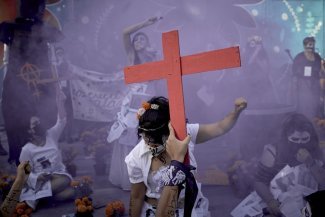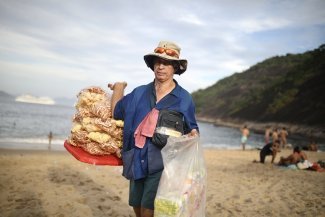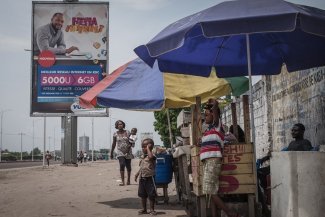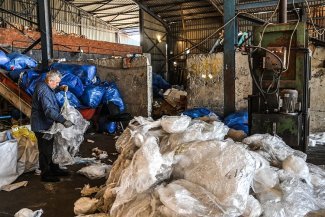
In this photo supplied by the Andina news agency, emergency teams work in the remains of a house destroyed by a landslide in Chosica, Peru, on 24 March 2017. The disaster rekindled fears of misappropriations in a country plagued by corruption.
“The other landslide we have experienced in recent months is corruption. Unfortunately, the quality of our municipal governments leaves a lot to be desired. Declaring a state of emergency would mean opening the door to corruption.”
This statement made by Pedro Pablo Kuczynski, the president of Peru, during an interview on CNN en Español, gave rise to considerable commentary. The country had just experienced one of its worst ever natural disasters and many Peruvians were calling for the declaration of a state of emergency.
At the end of March, huge landslides caused by torrential rains affected 630,000 people. Almost 100,000 people were left homeless and the material damage was substantial.
The president, however, refused to succumb to public pressure. Why? As millions of dollars in aid flowed into the country from abroad following the tragedy, Peru found itself wrestling with its demons. If a state of emergency were declared, the municipalities would be freed of the obligation to issue calls for tender. What could be done, in that case, to ensure funding was not siphoned off into the pockets of corrupt officials? The question is by no means incidental in a country that has seen a dramatic rise in the number of corruption scandals exposed since the beginning of the year.
The most prominent case is that of the Brazilian company Odebrecht, which allegedly paid out over US$29 million to Peruvian officials between 2005 and 2014, in return for highly lucrative contracts.
In an interview with Equal Times, Jaris Mujica, a researcher at the Pontifical Catholic University of Peru (PUCP), stressed the importance of distinguishing between the various types of corruption affecting the country.
“The biggest problem is the administrative corruption. It is massive here. Some do it to get rich, but most of the time it’s about networking. Public servants have short contracts, so they have to think about what they are going to do next.”
Peru fell 29 places in Transparency International’s Corruption Perception Indexbetween 2008 and 2016. The country now ranks 101st, with a score of 35/100.
Walter Alban, executive director of Proética, the Peruvian chapter of Transparency International, fears the worst is yet to come.
“We have seen the arrival of foreign mafias, drawn by the weakness of our institutions and the sheer scale of the informal economy. They started out by paying bribes to be able to traffic more easily. Not only is most of the police force now corrupt, but the country’s judiciary is too. And with money, they have acquired greater power. Nowadays, they are strongly influential in certain elections, giving them control over elected representatives.”
According to a poll conducted by the Peruvian daily La República, corruption is now seen as Peru’s second biggest problem (52 per cent), surpassed only by the issue of violence (61 per cent).
Politicians are no strangers to this phenomenon. In 2014, the Public Prosecutor’s Office in charge of corruption announced that 92 per cent of the country’s municipal councils were being investigated for corruption. As for the regional governors, 21 out of the 26 in total have been accused or convicted.
Peru has a long history of problems with the integrity of its representatives. Alan Garcia, president from 1985 to 1990, was accused of corruption. Saved by the statute of limitations, he was re-elected to the presidency in 2006. And the list goes on. Fernando Belaunde, Alberto Fujimori, Alejandro Toledo, Ollanta Humala and even Pedro Pablo Kuczynski: all the country’s presidents since 1980 have been directly or indirectly linked to corruption scandals.
Peruvians will tell you that you have to go back to San Martin, the founder of the Republic, to find a leader with a clean reputation.
“He steals but he does public works”
The old Peruvian maxim, “Roba pero hace obras” (He steals but he does public works), applies to the very highest levels of power.
For many people, the practical benefits to be drawn from an elected representative, such as a new road or bridge, are decisive in how they vote. The widely held belief that they are “all rotten”, places those taking concrete action at an advantage.
In 2014, ahead of the municipal election in Lima, the polling institute Datum asked an audacious question: “Who, in your view, will steal but do the most public works?”
Luis Castaneda, who went on to be elected mayor, was chosen by the 49 per cent of the respondents. His actions have come under close scrutiny since the disaster. In some parts of the city, the damage could have been much less devastating. But funds earmarked for disaster prevention were not deployed and others were used to improve Lima’s seafront. In addition, a bridge built during his previous term in office (2003-2010) mysteriously collapsed. Contraloría, a public auditing body, launched an inquiry echoing several cases in which his name appears.
Some, nevertheless, remain optimistic about the future. Dr Duberlí Apolinar Rodríguez, chief justice of the Supreme Court, gave Equal Times a rundown of the measures taken to improve the situation.
“In October, the president of the Republic passed the ‘civil death’ law. Thanks to this legislation, anyone convicted of corruption will no longer be able to take part in public service or hold public office. Then, in March, Congress voted in favour of making corruption offences imprescriptible. The Constitution should be amended in August, to reflect this change in legislation. We have also set up a specific system with 14 judges dedicated to fighting corruption in an effective manner.”
Julio Arbizu Gonzales, who served as an anti-corruption prosecutor from 2011 to 2014, has reservations about the system’s effectiveness. “Peru’s battery of anti-corruption laws was designed to dismantle the pyramidal organisation established by Alberto Fujimori and Vladimiro Montesinos.”
“But now we are faced with more segmented corruption and we haven’t yet managed to organise ourselves.”









